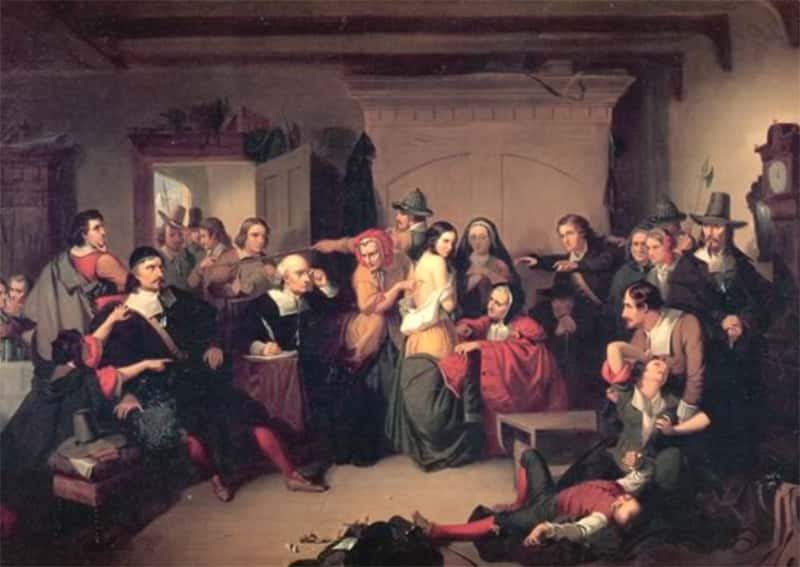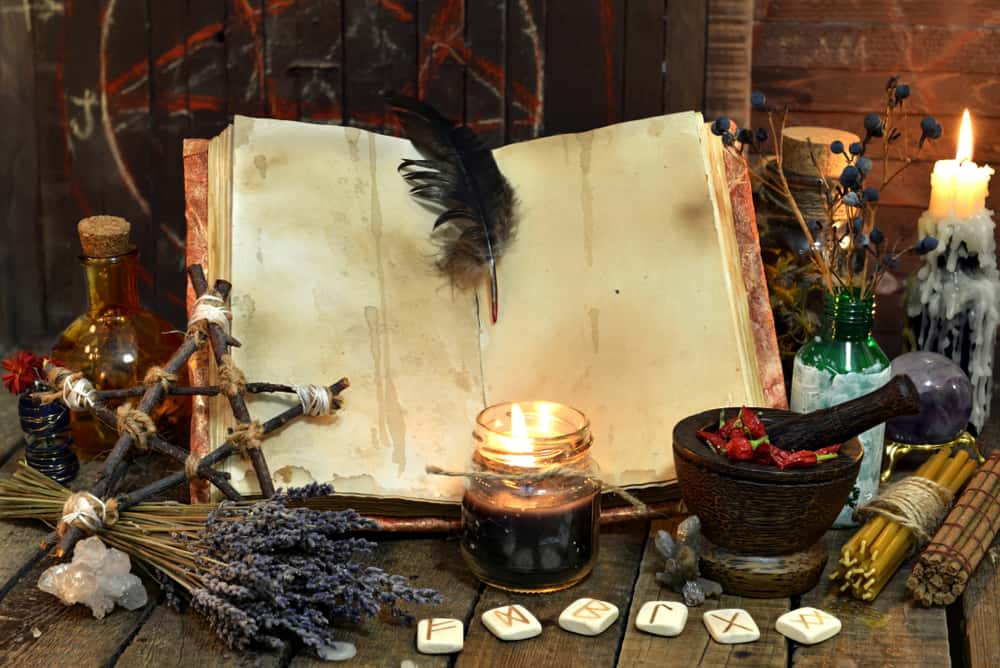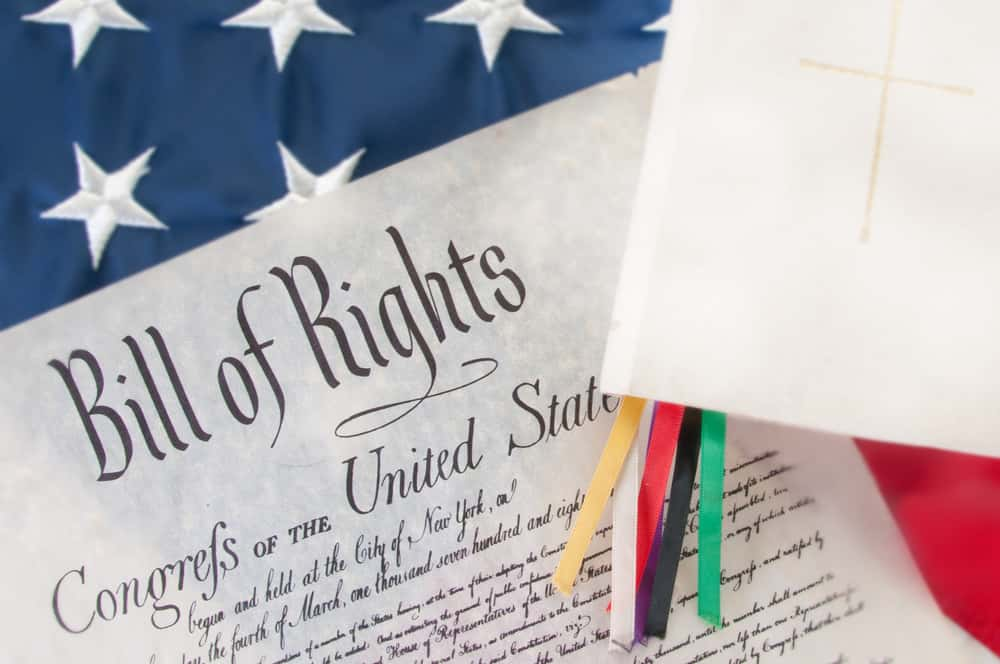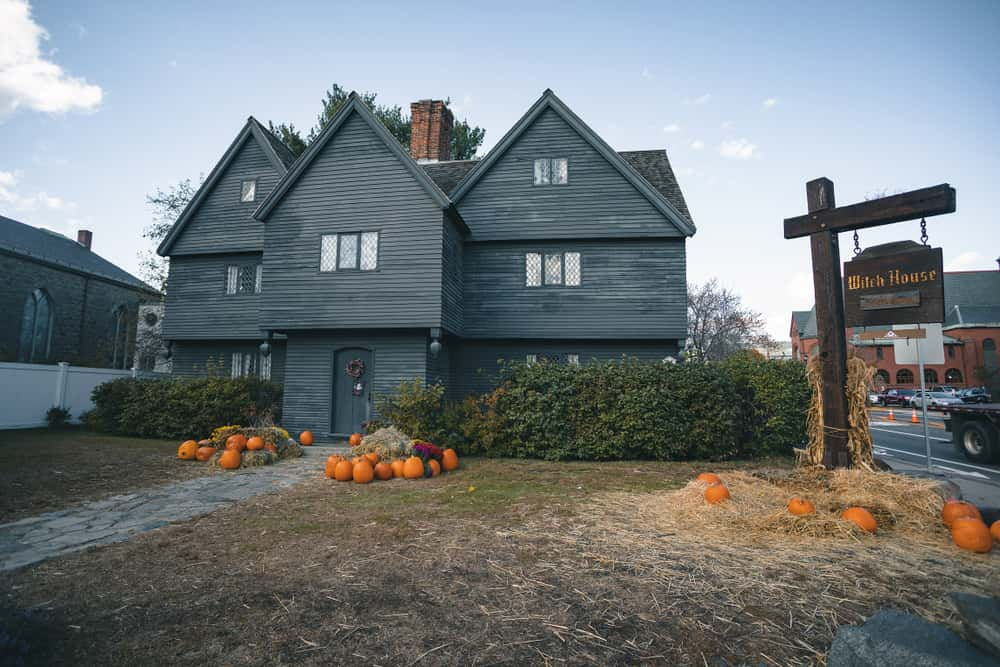“Life, woman, life is God's most precious gift; no principle, however glorious, may justify the taking of it.” —Arthur Miller, in The Crucible
The Salem witch trials of the late 17th century were a formative episode in America's early history, and have remained at the forefront of the national consciousness ever since. This series of prosecutions and hangings of those accused of practicing witchcraft provoked a major backlash, and the event still haunts us today. Here are 42 wicked facts about the Salem witch trials.
Salem Witch Trials Facts
42. Ancient History
Just when did the Salem witch trials take place in the timeline of American history? They began in 1692, a full 73 years before the start of the American Revolution and some 40 years before George Washington was even born.
Factinate Video of the Day
41. Location, Location, Location
For those who are unaware, Salem is located in Massachusetts, which, as you might remember from history class, was New England's first established colony dating back to the arrival of the Pilgrims of the Mayflower at Plymouth in 1620.
40. Net Result
When all was said and done, 25 people lost their lives because of the trials. 20 were executed (generally hanged) by the prosecutors, and five died while serving prison time. Two of the casualties were babies.
 Salem Witch Trials (2002 TV Movie), CBS
Salem Witch Trials (2002 TV Movie), CBS
39. To Be Precise
Despite being known as the "Salem" witch trials, some of the trials actually took place in Ipswich and Andover in addition to Salem itself.
38. The Puritans
The stars of the Salem story were the Puritan community of the Massachusetts Bay colony, a religious group that came over to America to escape religious persecution back in England. Which, yes, is a little ironic.

37. Mistaken Identity
Because of the similarity in time period, location, and story, people often mix up the Puritans with the Pilgrims, the group of Dutch settlers who created what we now know as the holiday of Thanksgiving. Credit where credit is due!
36. War on Christmas
Despite their obvious Christian commitment, the early American Puritans actually banned Christmas in the Massachusetts Bay colony in 1659, deeming it a sacrilege. Apparently they felt that giving gifts took away from one's ability to focus on serious religious thought, and they did not like the pagan origins of some aspects of the holiday. So if you celebrate Christmas and live in Massachusetts today, be happy you were born when you were!
35. Patients Zero
The panic and fear over witches hiding amongst the colony began when two young girls, Abigail Williams and Betty Parris, developed strange symptoms including having fits and screaming in pain at mysterious moments. They were eventually assumed to be possessed.
 The Crucible (1996), Twentieth Century Fox
The Crucible (1996), Twentieth Century Fox
34. Doctor's Orders
It was actually the local doctor, likely William Griggs, who first diagnosed the girls as having been “bewitched” when he couldn't find anything medically wrong with them to explain the strange behavior. I wonder if what the prescription is for that...
 Salem Witch Trials (2002 TV Movie), CBS
Salem Witch Trials (2002 TV Movie), CBS

History's most fascinating stories and darkest secrets, delivered to your inbox daily.
33. Not Unique
Don't feel too embarrassed if you happen to be from Massachusetts, you guys were not the first to do something like this. Witch trials had actually been a fairly common phenomenon in Europe during that period. In fact, there was fear in Europe that an entire group of evil witches were consciously attacking Europeans in order to destroy Christendom.

32. Figure of Speech
The phrase "witch hunt," commonly used to refer to an unjustified or falsely conjured-up prosecution, is thought to originate as a reference to this time period in American history.
 The Crucible (1996), Twentieth Century Fox
The Crucible (1996), Twentieth Century Fox
31. Prejudice
In the midst of all this religious and political controversy, there was also a major racial incident. It involved a woman by the name of Tituba, a most likely South American slave from Barbados, who was the first victim of Salem's witchcraft accusations. Tituba initially denied the claim that she was a witch, but notoriously later decided to confess that it was true and accused two other women as well in the process. Tituba ultimately survived the saga and was not hanged.
 Salem (2014–2017), 20th Century Fox Television
Salem (2014–2017), 20th Century Fox Television
30. Door to Door Witch Hunters
Part of the escalation of the Salem trials included investigators literally going door to door and asking homeowners to rat out any suspected witches in their midst. This often led to panicked citizens pointing out their innocent neighbors, adding to the rising toll of victims.
 The Crucible (1996), Twentieth Century Fox
The Crucible (1996), Twentieth Century Fox
29. Clowning Around
The Salem witch trials are considered one of America's most noteworthy cases of mass hysteria. There have been many other instances of this kind of phenomenon since—most recently in an outbreak of alleged evil clown sightings across the continent and beyond in 2016.
 Salem (2014–2017), 20th Century Fox Television
Salem (2014–2017), 20th Century Fox Television
28. Objections
Even during the trials, there were many who objected to the whole procedure, even within the religious Puritan community. An important minister in Boston named Increase Mather was one of these objectors, stating that “It were better that ten suspected witches should escape than that one innocent person should be condemned.”
27. Martha Corey
One of the most famous victims of the trials was a prominent woman in the local community named Martha Corey. The story goes that Corey and her husband, Giles, sat in on the trials early on, causing Martha to express scepticism about the legitimacy of the proceedings. The next time Giles wanted to attend, Martha objected and prevented him from going. This caused her to be accused of conspiring on behalf of the witches, and eventually of being a witch herself.
26. Controversial Past
Although Giles was a wealthy farmer and Martha was a prominent church member, both of them had pasts they weren't exactly advertising to the public. Giles had actually been accused and found guilty of murdering one of his farm hands years earlier, but was let off with just a fine!
25. Rivals
Thomas Maule, a Quaker who found himself at odds with the Puritan community at times, was beaten and imprisoned for speaking out against the trials, despite the fact that he himself believed in witches.
 Salem Witch Trials (2002 TV Movie), CBS
Salem Witch Trials (2002 TV Movie), CBS
24. Repeat
Many parallels have been drawn between the events of Salem and the tactics used by the government during the Red Scare of the 1950s, in which Senator Joseph McCarthy very harshly interrogated and went after anyone suspected of being a communist sympathizer.
23. Allegory
Arthur Miller, the famous playwright who authored Death of a Salesman, responded to the McCarthy hysteria by writing The Crucible, a play about the Salem witch trials, as a metaphor for what the country was going through in the 1950s.
22. Family Feud
Move over Montagues and Capulets: You might not be the most vengeful families out there. A complicated and long-lasting feud between the Putnam and Porter families of Salem may have been a motivating factor in some of the witchcraft accusations. It seems that a shocking number of accusations were made by members of the Putnam family.
 Salem Witch Trials (2002 TV Movie), CBS
Salem Witch Trials (2002 TV Movie), CBS
21. Different Times
In 1692, when the Salem witch trials began, the United States Constitution did not yet exist. Today, witchcraft is recognized by the government as a protected and legitimate religion under the First Amendment. So if you are a witch, no need to worry about this ever happening again!
20. Family History
Some of the families now only remembered for their connection to the trials had actually been important and well-known people before that. For example, the infamous Putnam family had been one of the earliest settler dynasties to come to the Massachusetts Bay colony and establish themselves there.
 The Crucible (1996), Twentieth Century Fox
The Crucible (1996), Twentieth Century Fox
19. Inter-species Crimes
In addition to the twenty people convicted and executed for witchcraft, two dogs were also accused of and executed for the same crime.
18. Pleading the Fifth
Another reason why it sucked that these trials took place before the Bill of Rights existed? One person was even executed for refusing to testify at the hearings. Unlike the others who were hanged, this unfortunate fellow was crushed to death by stones.
17. Wicked Romcom
The 1942 romantic comedy film I Married a Witch, starring Veronica Lake and Frederic March, told the story of two witches from Salem placing a revenge curse on the descendants of their accuser. No, it doesn't sound that romantic or comic to me either.
 I Married a Witch (1942), Paramount Pictures
I Married a Witch (1942), Paramount Pictures
16. Witches in the Living Room
Several episodes of the original Bewitched TV series were actually filmed on location in Salem.
15. History Brought to Life
Arthur Miller's play The Crucible played a large role in popularizing many of the details of the Salem witch trials and dramatizing facts that he uncovered in historical records. While Miller maintained that he kept everything historically accurate, some have noted that he made changes to the real record for the sake of the play.
14. Drama
When Miller's The Crucible was produced, it was in the aftermath of his feud with Elia Kazan, the man who had directed his two earlier hit plays All My Sons and Death of a Salesman. The feud was over the fact that Kazan had named communist sympathizers during his testimony to Congress. Miller did not approve of this, and this was one of the things he tried to criticize allegorically through his depiction of the Salem events.
13. The...What?
Miller's famous play about the Salem witch trials is called The Crucible...but what is a crucible anyway? A crucible is a kind of container used for heating substances at very high temperatures, and the term is often used to describe high pressure situations—such as the one the witch trials creates for the accused.

12. Self-Sacrifice
Another famous incident from the trials was the case of John Proctor. His wife, Elizabeth, had been accused of witchcraft and John tried to step in to defend her. This resulted in him being accused as well, and in the end it was he who was executed while Elizabeth was instead sentenced to prison so that her unborn baby would not have to die.
 The Crucible (1996), Twentieth Century Fox
The Crucible (1996), Twentieth Century Fox
11. Turning Point
One of the turning points in ending public support and enthusiasm for the trials was the conviction and execution of one of the town's former minsters, George Burroughs, who publicly recited the Lord's Prayer at the gallows, which was believed to be impossible for witches to do.
10. Abrupt Ending
The trials came to an abrupt halt when the Governor's wife was accused of witchcraft, causing him to immediately order an end to the trials.
9. Never the Same
Not that Salem didn't have its problems to begin with, but the community never fully recovered from the witch trials saga, and the divisions and setbacks to the town's development continued in the years following the trials.
 Salem (2014–2017), 20th Century Fox Television
Salem (2014–2017), 20th Century Fox Television
8. Possible Suspect
Some have suggested that the man who was truly responsible for initiating the witch trial debacle was Reverend Samuel Parris, the father and uncle of the afflicted girls. Even some members of his congregation at the time wanted to see him dismissed from his pew in response to his aggressive prosecuting role in the episode.
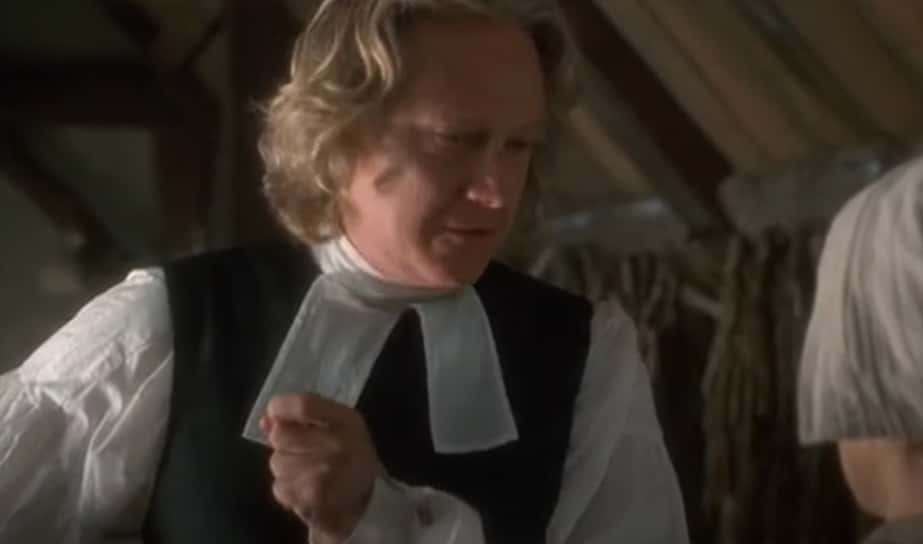 The Crucible (1996), Twentieth Century Fox
The Crucible (1996), Twentieth Century Fox
7. Modern Application
Although Massachusetts has given up its fight against witchcraft, there are still places in the world where witchcraft is legitimately feared by the public, sometimes even leading to real modern day witch hunts.
6. Gallows Humor
Despite the Salem witch trials occurring centuries ago, researchers only just found the execution site for the trials in 2016. They found it by following clues in an accused witch's writings and through guesses on where prisoners would be transported. Gallows Hill was discovered on a rocky outcropping now located, very unfittingly, near a Walgreen's in Salem.
5. Spectral Evidence
Much of the evidence brought agains the "witches," at least at first, was called "spectral evidence," where people testified to seeing an apparition of the accused trying to inflict harm on them. This evidence was later banned by the courts, leading to a sharp drop in accusations. Other proof was the "touch test," where if a witch who cursed someone touched the cursed person in the midst of a fit, theit fit would stop.

4. A Family Matter
Descendants of the Salem community have made constant efforts to clear the names of those ancestors and relatives who were falsely accused and convicted back in the 1690s, with some being officially recognized as innocent by the Massachusetts government as recently as the beginning of the 21st-century.
3. So What Really Happened?
So if witchcraft wasn't really happening in Salem, what actually caused those girls to have the fits? Many possible answers have been proposed, but one likely explanation is that they were suffering from some kind of natural medical afflictions. The community, beleaguered with hardships already, then overreacted. Another more disturbing theory proposed by researchers like behavioral psychologist Linnda Caporael suggests that Salem suffered from ergot poisoning. The people of Salem often ate rye bread, and in wet, swampy conditions (which Salem had at the time), rye can foster a fungus called ergot. Ergot causes hallucinations, convulsive fits, and sometimes death, and LSD derives from the substance. Even more interesting, the summer of 1692 was a dry one, and coincided with the apparent end of the bewitchments.
 Salem (2014–2017), 20th Century Fox Television
Salem (2014–2017), 20th Century Fox Television
2. Haunted Town
Due to its association with the supernatural and the haunted, Salem is now a popular destination for Halloween festivities, which run throughout the month of October.
1. Legacy
Despite the horrible and senseless loss of life and community divisions that the witch trials caused, some historians believe that the traumatic incident had a silver lining. They argue that the trials created a taboo in America against mixing religion and government, and George Lincoln Burr called it, “the rock on which the theocracy shattered.” There is also no question that the incident remains a constant reminder in our collective minds about the importance of due process in a legal system, and the dangers of premature overreaction and irrational hysteria.
 Salem (2014–2017), 20th Century Fox Television
Salem (2014–2017), 20th Century Fox Television
Sources: 1, 2, 3, 4, 5, 6, 7, 8, 9, 10, 11, 12, 13, 14, 15, 16, 17, 18, 19, 20, 21, 22, 23, 24, 25, 26, 27, 28, 29, 30, 31, 32, 33, 34




